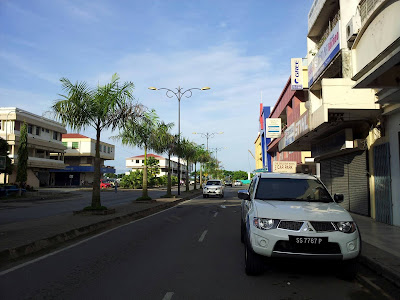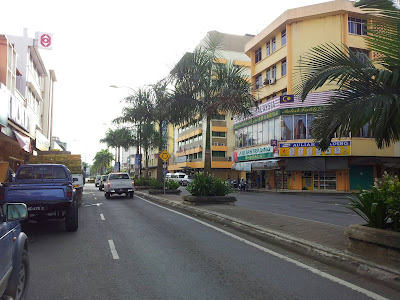Saturday 30 June 2012
Friday 29 June 2012
Tuesday 26 June 2012
Business Model
CHAPTER
NOTES
I. Business
Models
* Material following the opening feature on Amie Street.
1. A business model is a firm’s
plan or diagram for how it competes, uses its
resources, structures its
relationships, interfaces with customers, and creates
value to sustain itself on the
basis of the profits it earns.
2. It’s important to understand
that a firm’s business model takes it beyond its
own boundaries. Almost all firms partner with others to make
their business
models work.
3. There is no standard business
model, no hard-and-fast rules that dictate how
firms in a particular industry
should compete.
4. The term business model
innovation refers to initiatives such as that
undertaken by Michael Dell
that revolutionized how products are sold in an
industry.
5. The development of a firm’s
business model follows the feasibility analysis
stage of launching a new
venture but comes before the completion of a
business plan.
a. If a firm has conducted a feasibility
analysis and knows that it has a product
or service with potential,
the business model stage addresses how to
surround it with a core
strategy, a partnership model, a customer interface,
distinctive resources,
and a approach to creating value that represents a
viable business model.
b. At the business model development stage, it
is premature for a new venture
to raise money, hire a
lot of employees, establish partnerships, or
implement a marketing
plan. A firm needs to have a business
model in
place before it can make
additional substantive decisions.
A.
The Importance and Diversity of
Business Models
1.
Importance of Business Models
a.
Having a clearly articulate business model is
important because it
does the
following:
-
Serves as an ongoing extension
of feasibility analysis.
-
Focuses attention on how all
the elements of a business fit together and constitute a working whole.
-
Describes why the network of
participants needed to make a business idea viable would be willing to work
together.
-
Articulates a company’s core
logic to all stakeholders, including the firm’s employees
b.
Once a firm’s business model is clearly
determined, the entrepreneur
should diagram it on paper (to the extent
possible), examine it, and
ask the following questions:
-
Does my business model make
sense?
-
Will the businesses I need as
partners participate?
-
If I can get partners to participate,
how motivated will they be? Am I asking them work for or against their
self-interest?
-
How about my customers? Will it
be worth their time to do business with my company?
-
If I do get customers, how
motivated will they be?
-
Can I motivate my partners and
customers at a sufficient scale to cover the overhead of my business and make a
profit?
-
How distinct will my business
be? If I’m successful, will it be easy for a large competitor to step in and
steal my idea?
-
2.
Diversity of Business Models
a.
There is no standard business
model for an industry or for a target
market within an
industry. For example, there are five
distinct ways
that online
companies make money. These approaches,
shown in
Table 6.1, are
the core piece of their respective company’s business
models.
b.
There are always opportunities
for business model innovation. Think of
Netflix in movie rentals, Wikipedia in encyclopedias, and Curves
International in
fitness clubs.
II. How
Business Models Emerge
1.
The value chain is a model
developed by an academic researcher that many businesspeople as well as
entrepreneurs use to identify opportunities to enhance their competitive
strategies.
2.
The value chain is the string
of activities that move a product from the raw material stage, through manufacturing
and distribution, and ultimately to the end user.
3.
By studying a product or
service’s value chain, and organization can identify ways to create additional
value and assess whether it has the means to do so.
4.
Value chain analysis is also
helpful in identifying opportunities for new businesses and in understanding
how business models emerge.
5.
A firm can be formed to
strengthen the value chain for a product, however, only if a viable business
model can be created to support it.
III. Potential
Fatal Flows of Business Models
1.
Two fatal flaws can render a
business model untenable from the beginning.
a.
A complete misread of
customers.
b.
Utterly unsound economics.
IV. Components
of an Effective Business Model
A. Core Strategy
1. The first component of a business model is
the core strategy, which
describes how a firm
competes relative to its competitors.
The following
are the essential
components of a firm’s core strategy.
a.
Mission Statement. A firm’s mission, or mission statement,
describes
why it exists and
what its business model is supposed to accomplish
b. Product/Market Scope. A company’s product/market scope defines
the products and
markets on which it will concentrate.
c. Basis for Differentiation. It is important that a new venture
differentiate
itself from its
competitors in some way that is important to its
customers. If a new firm’s products or services aren’t
different from
those of its
competitors, why should anyone try them?
i. From a broad perspective, firms typically
choose one of two generic
strategies
(cost leadership or differentiation) to position themselves
in the
marketplace.
ii. Firms that have a cost leadership strategy
strive to have the lowest
costs in the
industry, relative to competitors’ costs, and typically
attract
customers on that basis.
iii. In contrast, firms with a
differentiation strategy compete on the basis
of providing
unique or different products and typically compete on
the basis of
quality, service, timeliness, or some other important
dimension.
B. Strategic Resources
1. A firm is not able to implement a strategy
without resources, so the
resources a firm has
affects its business model substantially.
The two
most important strategic
resources are discussed below.
a. Core Competency. As defined in Chapter 3, a core competency is
a resource or
capability that serves as a source of a firm’s competitive
advantage over its
rivals. Examples of core competencies
include
Sony’s competence in
miniaturization, Dell’s competence in supply
chain management, and 3M’s competence
in managing innovation.
b. Strategic Assets. Strategic assets are anything rare and
valuable that
a firm owns. They include plant and equipment, location, brands,
patents, customer
data, a highly qualified staff, and distinctive
partnerships.
2. Companies ultimately try to combine their
core competencies and
strategic assets to
create a sustainable competitive advantage.
This
factor is one to which
investors pay close attention when evaluating
a business.
C. Partnership Network
1. A firm’s network of partnerships is the third
component of a business
model. New ventures, in particular, typically do not
have the resources
to perform all the tasks
required to make their businesses work, so they
rely on partners to
perform key roles.
a.
Suppliers. A supplier (or a vendor) is a company that
provides parts
or services to
another company. Almost all firms have
suppliers who
play a vital
roles in the functioning of their business models.
b. Other Key Relationships. Along with its
suppliers, firms partner with
other companies to
make their business models work.
i. There are risks involved in partnerships,
particularly if a single
partnership is a
key component of a firm’s business model.
ii. Many
partnerships fall short of meeting the expectations of the
participants for
a variety of reasons.
C.
Customer Interface
1. Customer interface – how a firm interacts
with its customers – is the fourth
component of a business model. The type of customer interaction depends
on how a firm chooses to compete.
a.
Target Market. A firm’s target
market is the limited group of
individuals or businesses that it
goes after or tries to appeal to.
i.
The target market a firm selects affects everything it does, from
the strategic assets it acquires
to the partnerships it forges to its
promotional campaigns.
b.
Fulfillment and Support. Fulfillment and support describes the way
a firm’s product
or service “goes to market” or how it reaches its
customers. It also refers to the channels a company uses
and what level
of customer
support it provides.
c.
Pricing Structure. A third element of a company customer
interface is
its pricing
structure. Pricing models vary,
depending on a firm’s target
market and its
pricing philosophy.
Tuesday 19 June 2012
Saturday 16 June 2012
Sarawak needs more palm oil mills to stem loss
by Wilfred Pilo. Posted on October 2, 2011, Sunday
KUCHING: Millions of ringgit will continue to be lost if the plight of palm oil plantations and smallholders is not addressed as soon as possible due to the shortage of palm oil mills in the state.
Minister of Land Development Tan Sri Dr James Masing said this when contacted Friday.
The matter has now worsened as the supply of fresh fruit bunches (FFBs) has overwhelmed the capacity of present oil palm mills.
To put an end to the continual loss of not only money but unprocessed FFBs, he agreed that there was an urgent need to establish and build more oil palm mills in Sarawak.
“Until and unless the Malaysian Palm Oil Board encourages oil palm planters to build more mills we are in danger of losing revenue from this industry.
“The government is very concerned over the matter and will look into this as soon as possible,” he asserted.
Masing also sympathised with the plantations and especially smallholders who had to suffer due to the deterioration of FFBs because of the long waiting period at the mills.
According to a news report in the Borneo Post on Wednesday, if the FFBs are not processed immediately, the oil extraction rate (OER) of the unprocessed stock would drop by one per cent per day.
An experienced palm oil industry player stated in the news report that because of the unprocessed stock and low OER, smallholders could lose millions of ringgit a month if the mills are unable to process their produce.
Not only that, he said industry players may risk rejection at the processing hub despite the round-the clock mill operation due to the over flowing supply of FFBs.
Industry players in the state also feel that Sarawak has far exceeded the official record of the 900,000 hectares of land cultivated with palm oil as production from smallholdings and smaller plantations have not been taken into account by the authorities.
Plantation owners however said that they do not blame the government as MPOB rarely turns down their industry application for new mills and they hope the situation would be solved soon.
Currently, the state has 52 mills in operation and to meet the current demand and needs, industry players want at least 30 new mills to be built.
Read more: http://www.theborneopost.com/2011/10/02/sarawak-needs-more-palm-oil-mills-to-stem-loss
One pct hike in OER can raise palm oil income by RM458 mln
Posted on December 19, 2010, Sunday
KUALA LUMPUR: Palm oil companies are already exceeding Malaysia’s oil extraction rate (OER) targets, a move clearly reflecting the industry’s increased productivity and efficiency.
Minister of Plantation Industries and Commodities Tan Sri Bernard Dompok said to maximise the income for plantations and the industry, with prices hovering around RM3,000 per tonne, the OER needed to be upgraded to a much higher level.
“This can be achieved through management efficiency, quality practices and new technologies,” he said at the Palm Oil Industry Q Awards and dinner organised by the Malaysian Palm Oil Board (MPOB) recently.
He said a one per cent increase in the OER would give an additional income of RM458 million to the country’s palm oil industry based on average price of RM2,665 per tonne between January and November this year.
Ribubonus Palm Oil Mill (Perlis Plantation Oil Palm Bhd), which emerged the winner of the National Oil Extraction Rate Award for 2009/2010, achieved the national OER vision of 25 per cent.
“The awards are a recognition to the industry having achieved excellence and in the process have enhanced the image of the country’s palm oil industry,” the minister said.
He also said the move was a step in the right direction as it would position the industry well to chalk up a revenue of RM178 billion by 2020 envisaged under the Economic Transformation Programme where palm oil has been designated as among the National Key Economic Areas (NKEAs).
MPOB chairman Datuk Seri Utama Shahrir Samad, in his speech at the function, revealed that research undertaken by the board had resulted in 475 technologies and new innovations over the past 10 years in all aspects of palm oil including its commercialisation and contribution to industry development.
As of 2010, he said 30 per cent of MPOB technologies have been commercialised in areas such as planting materials, agronomy practices, farm mechanisation, milling and processing, formulation of food products, production of oleochemical products, biomass as well as palm oil-based biodiesel.
Meanwhile, Cargill Palm Products Sdn Bhd emerged champion in the National Refining Mills Category based on their refining efficiency as required by the ‘Refiner Certificate of Competency’ (RCOC). — Bernama
Read more: http://www.theborneopost.com/2010/12/19/one-pct-hike-in-oer-can-raise-palm-oil-income-by-rm458-mln
Stagnant Oil Extraction Rate (OER)
Concern over stagnant oil extraction rate
Commodities Talk - By Hanim Adnan
LOCAL palm oil production is looking strong, but the stagnant oil-extraction rate (OER) of palm oil, especially in Peninsular Malaysia that is below 20% for the past 20 years, has been a major concern.
In times of low crude palm oil (CPO) prices and low yields, producers are normally challenged to improve their OER performance. OER can be used as a management tool in assessing the performance of a mill or plantation, as profitability to a great extent is influenced by the amount of oil realised per hectare of land under cultivation.
Thanks to Sarawak and Sabah oil palm planters’ high OER of above 20%, the national OER average touched 20.21% in 2008.
However, this is not good enough as the Government strives for the national OER to hit 25% by 2020. It is also targeting a national fresh fruit bunches (FFB) rate of 35 tonnes and palm-oil yield at 8 tonnes per ha per year.
A straight forward answer to the stagnant OER in the peninsula can be due to the third or fourth generation “recycled” soil used to plant oil palm back in 1960s, which was previously planted with rubber trees, and also with tapioca and gambir trees during the Second World War in the 1940s.
Those oil palm trees in Sabah and Sarawak were planted in new agriculture soil, previously rainforest jungles, therefore guaranteeing higher yield and OER.
the government is targeting a national FFB of 35 tonnes per ha per year
Many also failed to realise that 21% of the oil palm trees in Peninsular Malaysia are 19 to 25 years old, leading to diminishing FFB yield by 1% to 2% per year as well as poor OER.
However, the overall stagnation in OER does not really reflect the credible OER and yield performance among efficient plantation groups like United Plantations Bhd, IOI Corp Bhd, Kuala Lumpur Kepong Bhd and Sime Darby Bhd.
These planters mostly achieved OER of 21%, CPO of five to six tonnes and FFB of over 28 tonnes per ha per year.
Many are pointing their fingers at the poor performance of the smallholders sector, which has resulted in the stagnation in OER and yield in the country.
Smallholders, which contribute about 45% to the total palm oil production nationwide, were somewhat reluctant to undertake replanting activities when CPO was trading above RM3,000 per tonne.
It is believed that smallholders’ OER now stands at only about 18%, CPO yield below 3 tonnes while FFB at 15 tonnes per ha per year.
Therefore, it was indeed a good move by the Government since late 2008 to allocate several incentives and funds to encourage more aggressive replanting of unproductive oil palm trees with superior clones among smallholders.
There is also talk that the Government will divide smallholders into clusters to expedite more structured replanting activities in the future.
Another effort to help improve the national OER is to upgrade the existing palm oil mills, which were set up back in the 1960s. There are a number of mills still operating with an OER of below 18%.
These mills will need to improve their OER through stringent FFB grading, rejecting unripe fruits and adopting new technology.
The oil palm industry needs to make concerted efforts, including improving agricultural practices, to push yields and productivity to new heights.
Hanim Adnan is assistant news editor at The Star. She feels that the Government must find a fast solution to help outdated palm oil mills improved on their OERs.
Ref ; The Star 14th April 2009
Biji sawit @ loose fruits
Ini biji sawit kawan.
dalam bijinya ada mesocarp. Bahagian yang menghasilkan crude palm oil, fibre dan juga bahan lain seperti air, sludge serta non oily solid.
dalamnya juga ada nut yang bertempurung berwarna hitam. Dalamnya ada palm kernel atau isirong sawit.
fiber gunanya untuk dijadikan bahan bakar, operasikan boiler, hasilkan stim, jana elektrik serta guna untuk pemanasan serta kukus buat sawit.
shell juga digunakan untuk dijadikan bahan bakar.
dua produk utama kilang sawit adalah CPO dan PK.
Namun, biji sawit bukan kilang yang buat kawan! Ia dibekalkan oleh ladang sawit. Kilang hanya proses sahaja.
Jadi, ladang sawit! tolong hantar biji banyak - banyak ya! sebab dalamnya ada dua produk penting kilang iaitu
1. CPO
2. PK
...salam.
dalam bijinya ada mesocarp. Bahagian yang menghasilkan crude palm oil, fibre dan juga bahan lain seperti air, sludge serta non oily solid.
dalamnya juga ada nut yang bertempurung berwarna hitam. Dalamnya ada palm kernel atau isirong sawit.
fiber gunanya untuk dijadikan bahan bakar, operasikan boiler, hasilkan stim, jana elektrik serta guna untuk pemanasan serta kukus buat sawit.
shell juga digunakan untuk dijadikan bahan bakar.
dua produk utama kilang sawit adalah CPO dan PK.
Namun, biji sawit bukan kilang yang buat kawan! Ia dibekalkan oleh ladang sawit. Kilang hanya proses sahaja.
Jadi, ladang sawit! tolong hantar biji banyak - banyak ya! sebab dalamnya ada dua produk penting kilang iaitu
1. CPO
2. PK
...salam.
Thursday 14 June 2012
Palm Oil Mill & Estate
Gambar daripada Google Map menunjukkan sebuah kilang sawit terletak di Borneo.
Ada kilang sawit.
Ada kolam effluent.
Ada ladang sawit.
Ada perumahan pekerja kilang dan ladang.
Ada kolam air untuk kegunaan kilang dan perumahan.
Ada jalan.
Sebuah pemandangan yang hebat!
Ada kilang sawit.
Ada kolam effluent.
Ada ladang sawit.
Ada perumahan pekerja kilang dan ladang.
Ada kolam air untuk kegunaan kilang dan perumahan.
Ada jalan.
Sebuah pemandangan yang hebat!
Saturday 2 June 2012
Jangan bertapi - tapi untuk ke Kg Tampi - Tampi, Semporna, Sabah.
Airport Lahad Datu
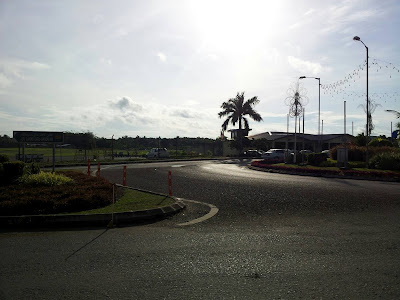
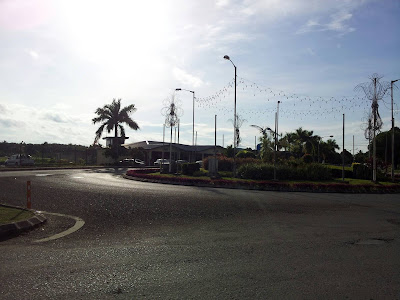
Walaupun saiznya masih sama, namun bangunan kayunya berubah menjadi batu selepas 8 tahun.
Landskaping dan juga kebersihan bertambah baik.
Semuanya bermula di sini bilamana Awang sampai ke Sabah.
Dari sini Awang dijemput oleh pemandu LPOM Lajuneda. Namanya laju, tapi dia memandu dengan penuh berhati - hati dan pelahan.
Maklumlah, jalan Jeroco paling laju boleh drive cuma 40 km/j.
Awang sempat 3 kali tertidur dan bangun.
Sebelum sampai ke MPOM B.
Published with Blogger-droid v2.0.4
Lahad Datu selepas kali pertama Awang menjejak kaki 16hb Mac 2004 dan masuk ke industri sawit
Melawat Projek Kambing Ir Azmer


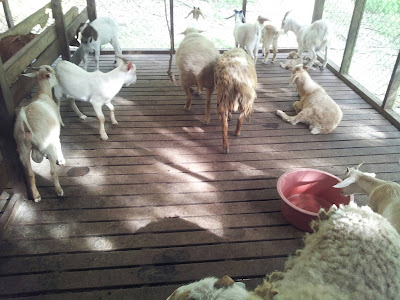
Awang membeli 2 ekor anak kambing jenis boer.
Selepas mendapat harga istimewa dari mentornya Ir Azmer.
Dalam hati Awang... satu hari nanti aku pun mau jumlahnya macam ni.
Published with Blogger-droid v2.0.4
Subscribe to:
Posts (Atom)









